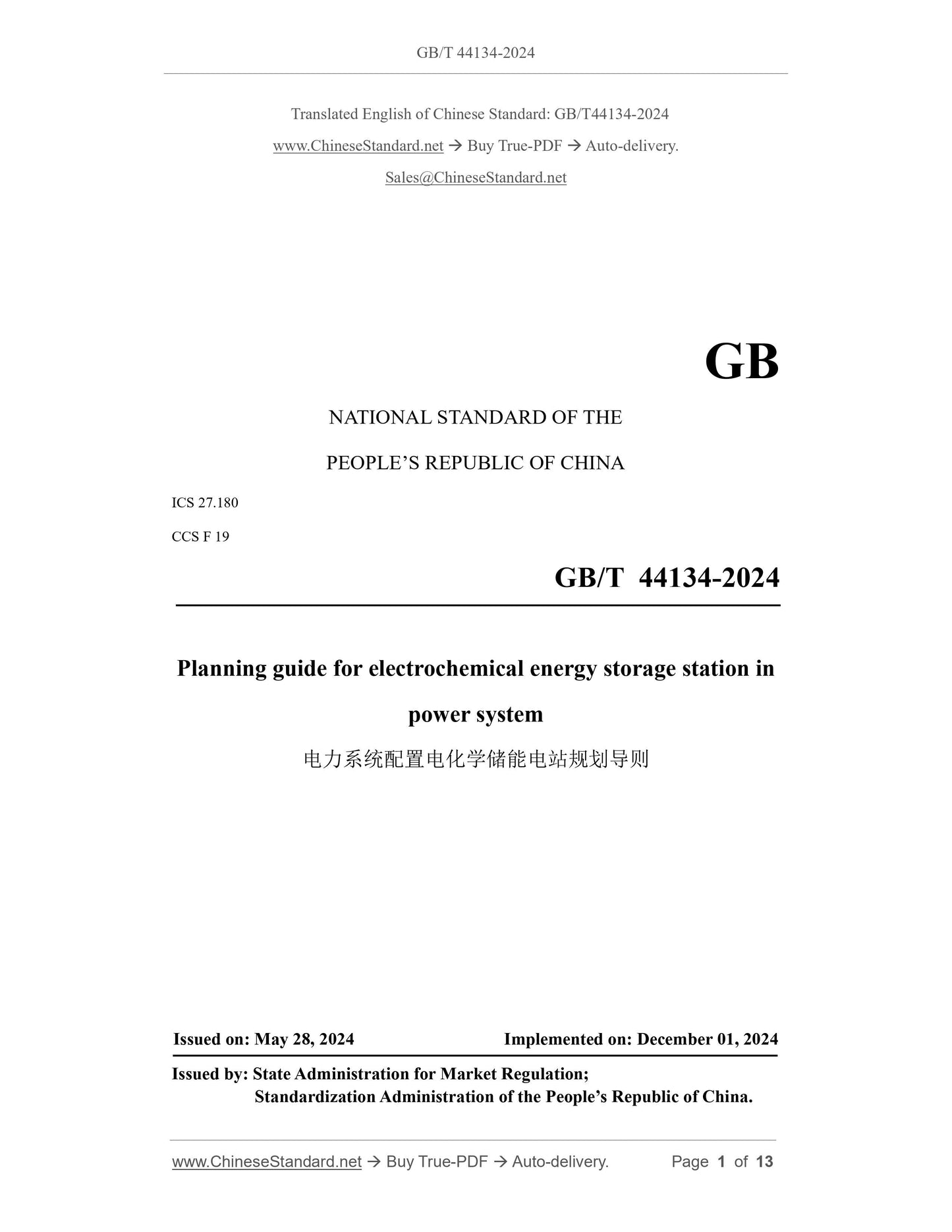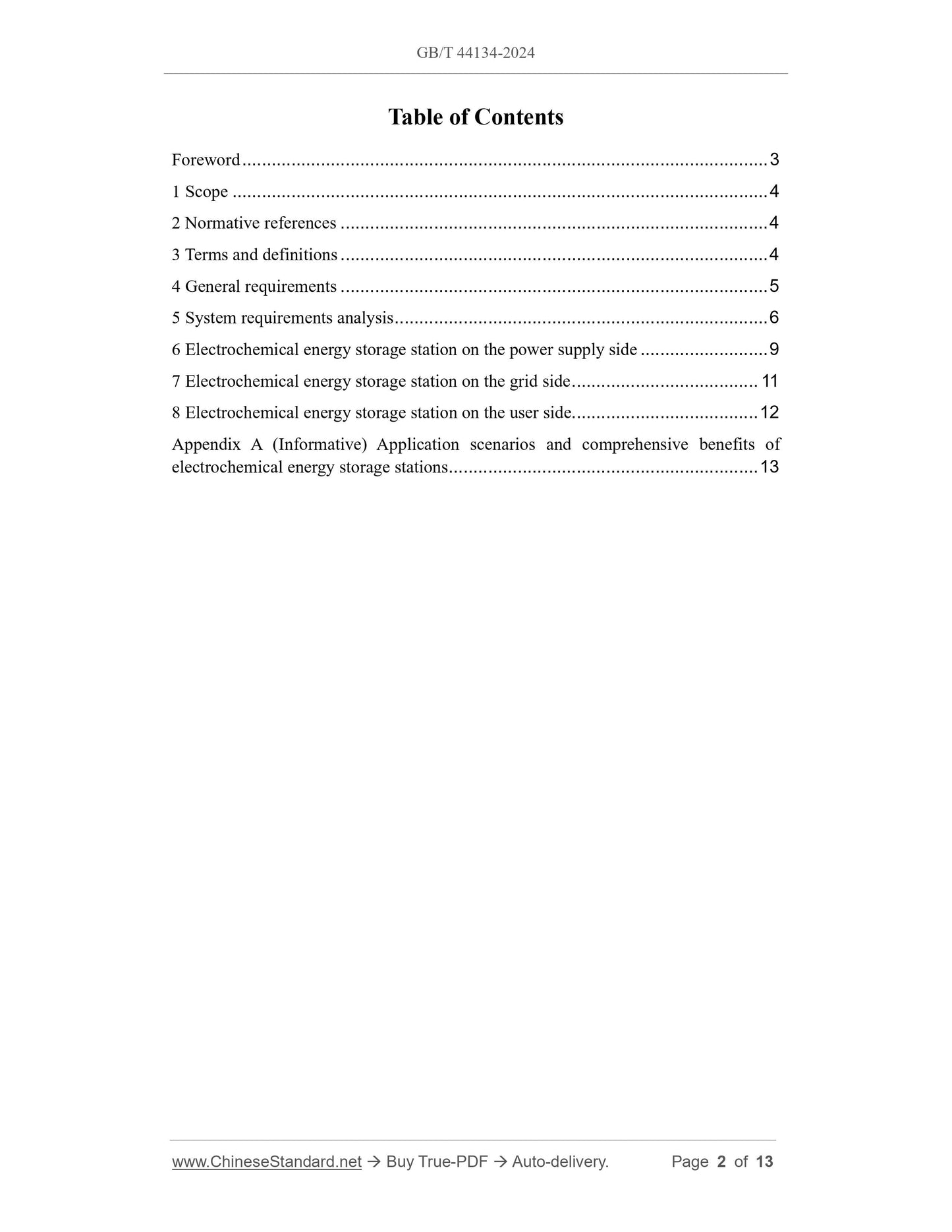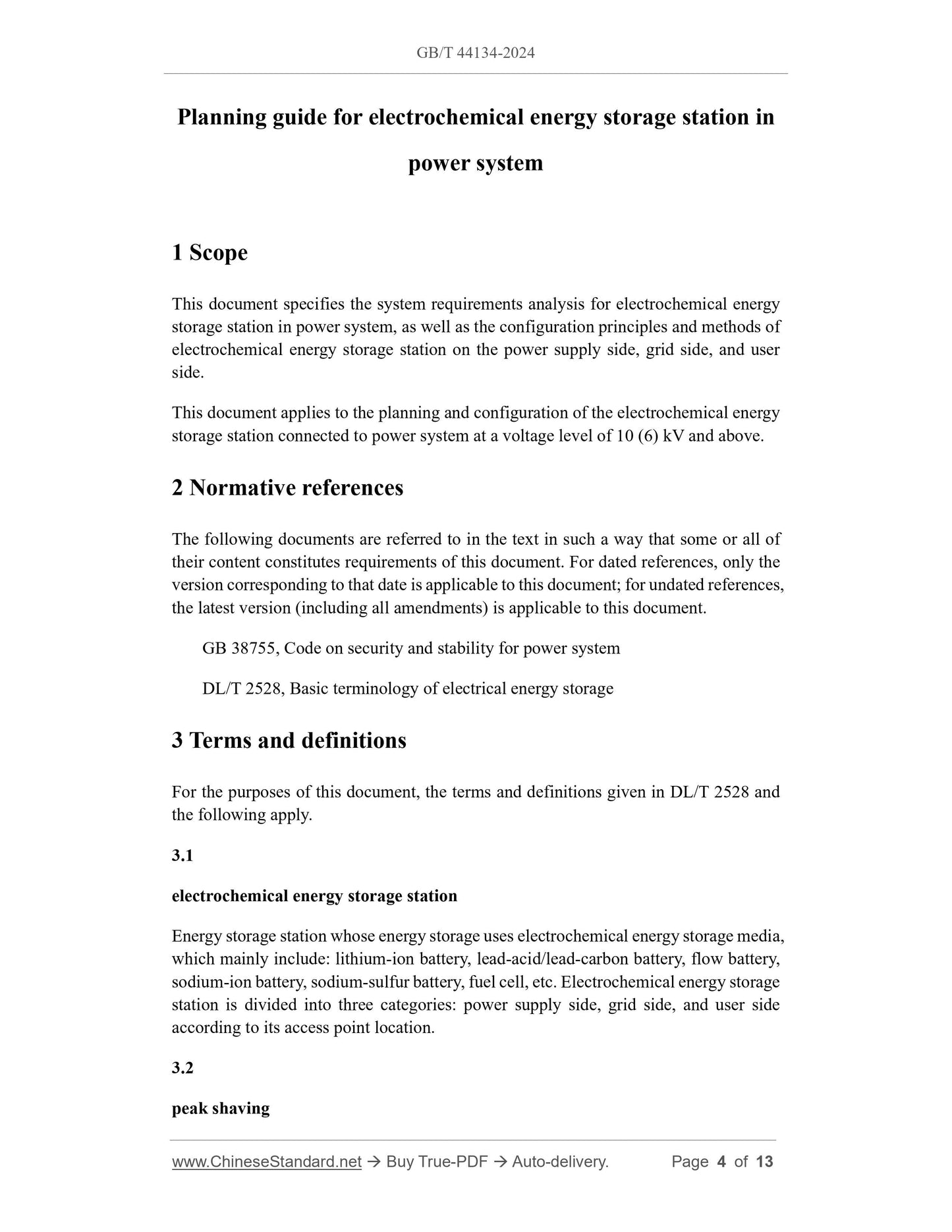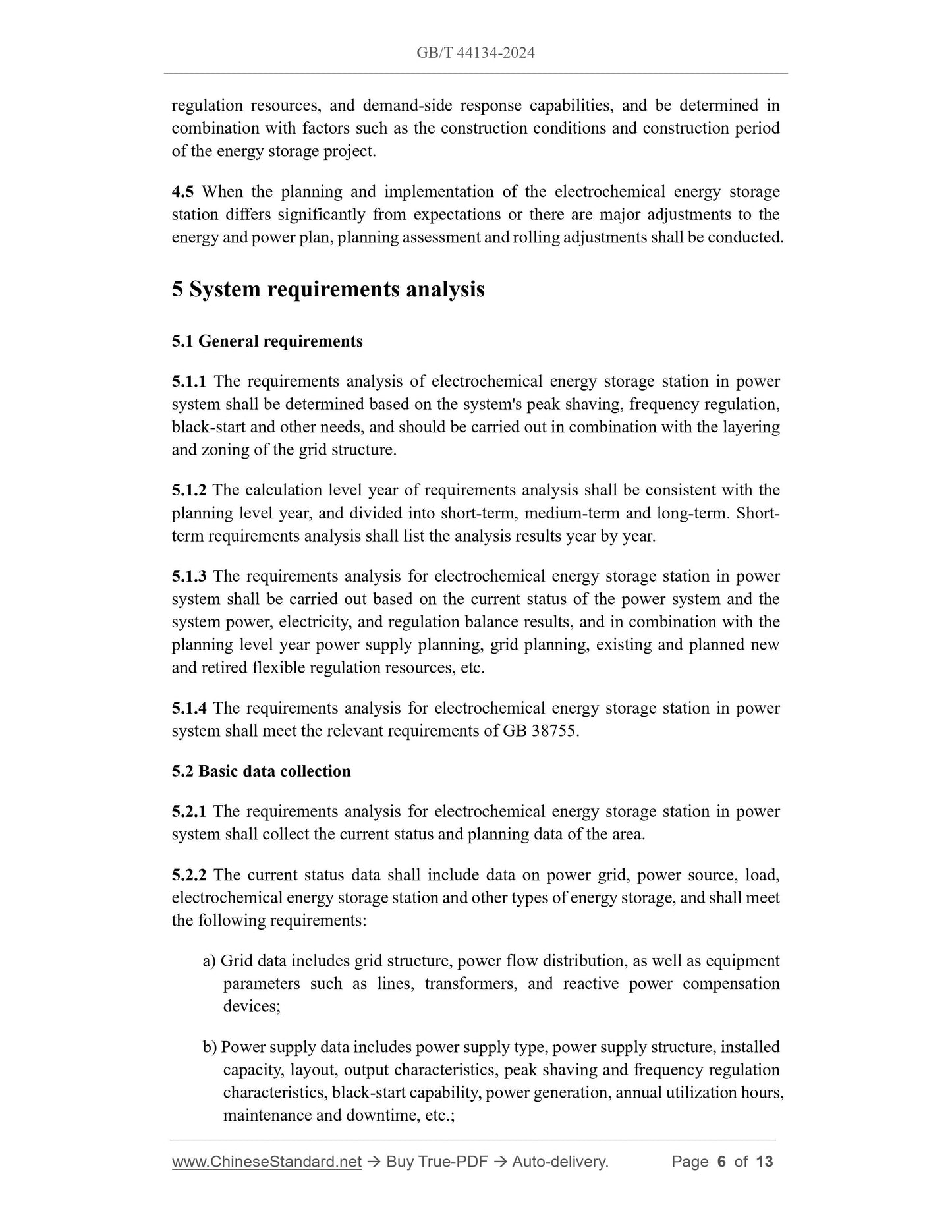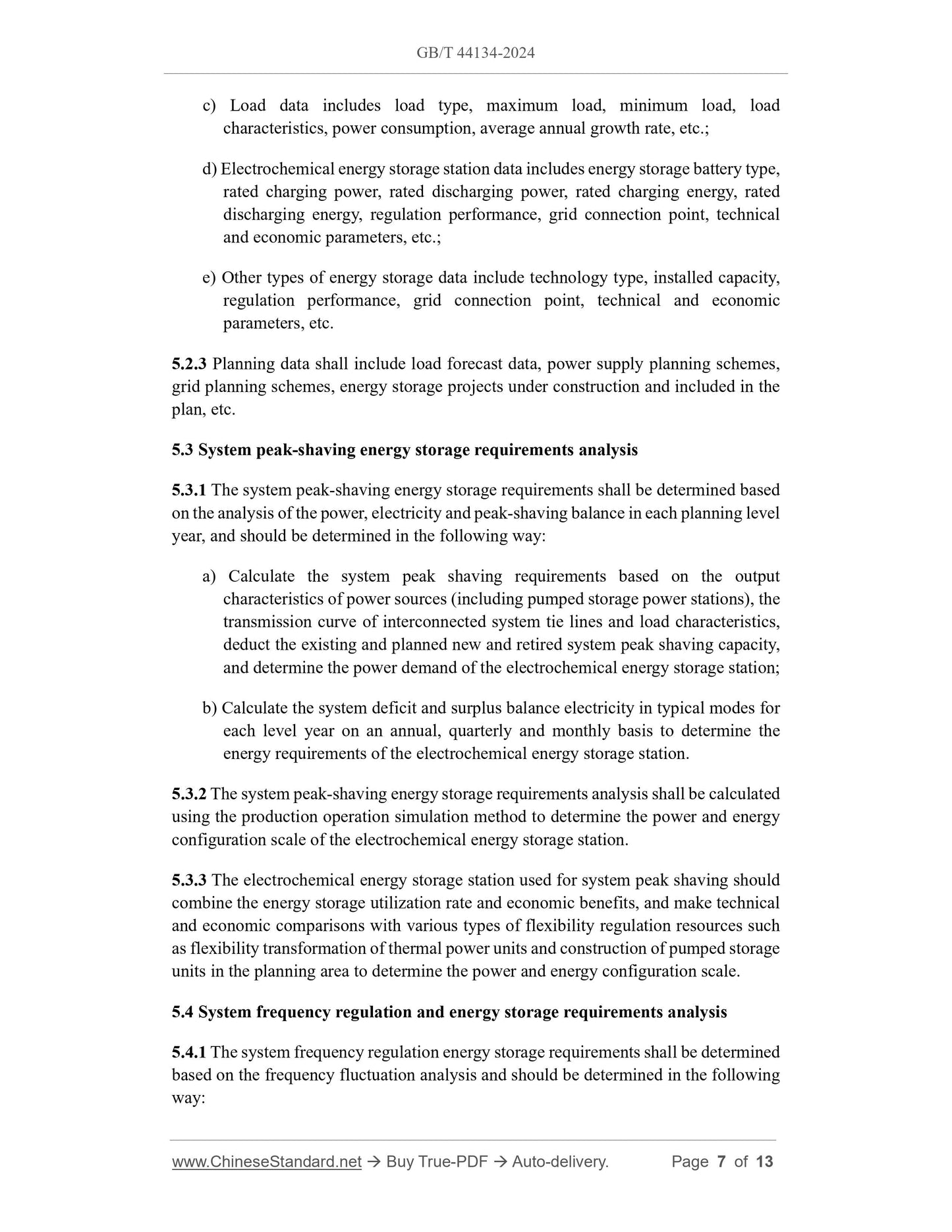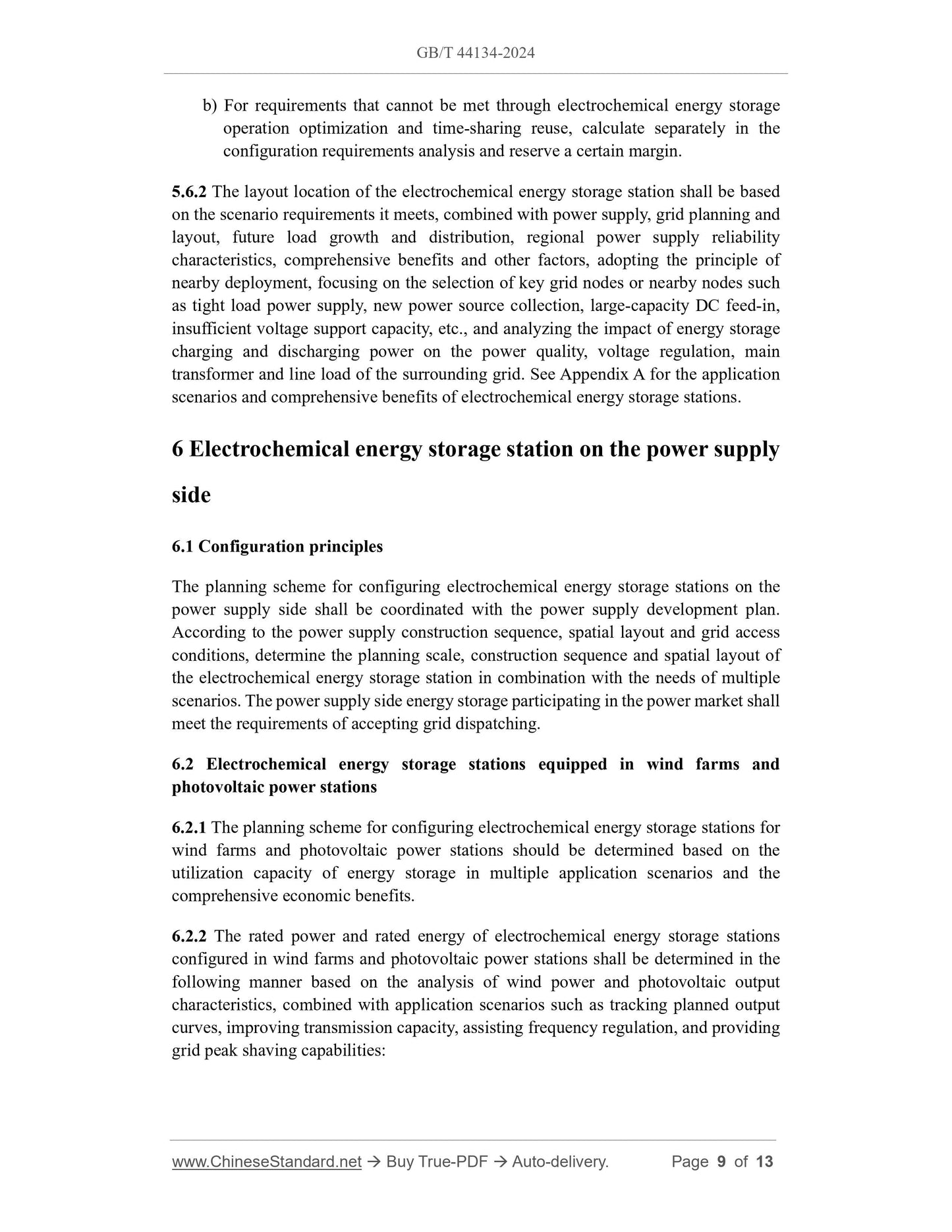1
/
of
8
PayPal, credit cards. Download editable-PDF and invoice in 1 second!
GB/T 44134-2024 English PDF (GBT44134-2024)
GB/T 44134-2024 English PDF (GBT44134-2024)
Regular price
$275.00 USD
Regular price
Sale price
$275.00 USD
Unit price
/
per
Shipping calculated at checkout.
Couldn't load pickup availability
Delivery: 3 seconds. Download true-PDF + Invoice.
Get QUOTATION in 1-minute: Click GB/T 44134-2024
Historical versions: GB/T 44134-2024
Preview True-PDF (Reload/Scroll if blank)
GB/T 44134-2024: Planning guide for electrochemical energy storage station in power system
GB/T 44134-2024
GB
NATIONAL STANDARD OF THE
PEOPLE’S REPUBLIC OF CHINA
ICS 27.180
CCS F 19
Planning guide for electrochemical energy storage station in
power system
ISSUED ON: MAY 28, 2024
IMPLEMENTED ON: DECEMBER 01, 2024
Issued by: State Administration for Market Regulation;
Standardization Administration of the People’s Republic of China.
Table of Contents
Foreword ... 3
1 Scope ... 4
2 Normative references ... 4
3 Terms and definitions ... 4
4 General requirements ... 5
5 System requirements analysis ... 6
6 Electrochemical energy storage station on the power supply side ... 9
7 Electrochemical energy storage station on the grid side ... 11
8 Electrochemical energy storage station on the user side... 12
Appendix A (Informative) Application scenarios and comprehensive benefits of
electrochemical energy storage stations ... 13
Planning guide for electrochemical energy storage station in
power system
1 Scope
This document specifies the system requirements analysis for electrochemical energy
storage station in power system, as well as the configuration principles and methods of
electrochemical energy storage station on the power supply side, grid side, and user
side.
This document applies to the planning and configuration of the electrochemical energy
storage station connected to power system at a voltage level of 10 (6) kV and above.
2 Normative references
The following documents are referred to in the text in such a way that some or all of
their content constitutes requirements of this document. For dated references, only the
version corresponding to that date is applicable to this document; for undated references,
the latest version (including all amendments) is applicable to this document.
GB 38755, Code on security and stability for power system
DL/T 2528, Basic terminology of electrical energy storage
3 Terms and definitions
For the purposes of this document, the terms and definitions given in DL/T 2528 and
the following apply.
3.1
electrochemical energy storage station
Energy storage station whose energy storage uses electrochemical energy storage media,
which mainly include: lithium-ion battery, lead-acid/lead-carbon battery, flow battery,
sodium-ion battery, sodium-sulfur battery, fuel cell, etc. Electrochemical energy storage
station is divided into three categories: power supply side, grid side, and user side
according to its access point location.
3.2
peak shaving
regulation resources, and demand-side response capabilities, and be determined in
combination with factors such as the construction conditions and construction period
of the energy storage project.
4.5 When the planning and implementation of the electrochemical energy storage
station differs significantly from expectations or there are major adjustments to the
energy and power plan, planning assessment and rolling adjustments shall be conducted.
5 System requirements analysis
5.1 General requirements
5.1.1 The requirements analysis of electrochemical energy storage station in power
system shall be determined based on the system's peak shaving, frequency regulation,
black-start and other needs, and should be carried out in combination with the layering
and zoning of the grid structure.
5.1.2 The calculation level year of requirements analysis shall be consistent with the
planning level year, and divided into short-term, medium-term and long-term. Short-
term requirements analysis shall list the analysis results year by year.
5.1.3 The requirements analysis for electrochemical energy storage station in power
system shall be carried out based on the current status of the power system and the
system power, electricity, and regulation balance results, and in combination with the
planning level year power supply planning, grid planning, existing and planned new
and retired flexible regulation resources, etc.
5.1.4 The requirements analysis for electrochemical energy storage station in power
system shall meet the relevant requirements of GB 38755.
5.2 Basic data collection
5.2.1 The requirements analysis for electrochemical energy storage station in power
system shall collect the current status and planning data of the area.
5.2.2 The current status data shall include data on power grid, power source, load,
electrochemical energy storage station and other types of energy storage, and shall meet
the following requirements:
a) Grid data includes grid structure, power flow distribution, as well as equipment
parameters such as lines, transformers, and reactive power compensation
devices;
b) Power supply data includes power supply type, power supply structure, installed
capacity, layout, output characteristics, peak shaving and frequency regulation
characteristics, black-start capability, power generation, annual utilization hours,
maintenance and downtime, etc.;
c) Load data includes load type, maximum load, minimum load, load
characteristics, power consumption, average annual growth rate, etc.;
d) Electrochemical energy storage station data includes energy storage battery type,
rated charging power, rated discharging power, rated charging energy, rated
discharging energy, regulation performance, grid connection point, technical
and economic parameters, etc.;
e) Other types of energy storage data include technology type, installed capacity,
regulation performance, grid connection point, technical and economic
parameters, etc.
5.2.3 Planning data shall include load forecast data, power supply planning schemes,
grid planning schemes, energy storage projects under construction and included in the
plan, etc.
5.3 System peak-shaving energy storage requirements analysis
5.3.1 The system peak-shaving energy storage requirements shall be determined based
on the analysis of the power, electricity and peak-shaving balance in each planning level
year, and should be determined in the following way:
a) Calculate the system peak shaving requirements based on the output
characteristics of power sources (including pumped storage power stations), the
transmission curve of interconnected system tie lines and load characteristics,
deduct the existing and planned new and retired system peak shaving capacity,
and determine the power demand of the electrochemical energy storage station;
b) Calculate the system deficit and surplus balance electricity in typical modes for
each level year on an annual, quarterly and monthly basis to determine the
energy requirements of the electrochemical energy storage station.
5.3.2 The system peak-shaving energy storage requirements analysis shall be calculated
using the production operation simulation method to determine the power and energy
configuration scale of the electrochemical energy storage station.
5.3.3 The electrochemical energy storage station used for system peak shaving should
combine the energy storage utilization rate and economic benefits, and make technical
and economic comparisons with various types of flexibility regulation resources such
as flexibility transformation of thermal power units and construction of pumped storage
units in the planning area to determine the power and energy configuration scale.
5.4 System frequency regulation and energy storage requirements analysis
5.4.1 The system frequency regulation energy storage requirements shall be determined
based on the frequency fluctuation analysis and should be determined in the following
way:
b...
Get QUOTATION in 1-minute: Click GB/T 44134-2024
Historical versions: GB/T 44134-2024
Preview True-PDF (Reload/Scroll if blank)
GB/T 44134-2024: Planning guide for electrochemical energy storage station in power system
GB/T 44134-2024
GB
NATIONAL STANDARD OF THE
PEOPLE’S REPUBLIC OF CHINA
ICS 27.180
CCS F 19
Planning guide for electrochemical energy storage station in
power system
ISSUED ON: MAY 28, 2024
IMPLEMENTED ON: DECEMBER 01, 2024
Issued by: State Administration for Market Regulation;
Standardization Administration of the People’s Republic of China.
Table of Contents
Foreword ... 3
1 Scope ... 4
2 Normative references ... 4
3 Terms and definitions ... 4
4 General requirements ... 5
5 System requirements analysis ... 6
6 Electrochemical energy storage station on the power supply side ... 9
7 Electrochemical energy storage station on the grid side ... 11
8 Electrochemical energy storage station on the user side... 12
Appendix A (Informative) Application scenarios and comprehensive benefits of
electrochemical energy storage stations ... 13
Planning guide for electrochemical energy storage station in
power system
1 Scope
This document specifies the system requirements analysis for electrochemical energy
storage station in power system, as well as the configuration principles and methods of
electrochemical energy storage station on the power supply side, grid side, and user
side.
This document applies to the planning and configuration of the electrochemical energy
storage station connected to power system at a voltage level of 10 (6) kV and above.
2 Normative references
The following documents are referred to in the text in such a way that some or all of
their content constitutes requirements of this document. For dated references, only the
version corresponding to that date is applicable to this document; for undated references,
the latest version (including all amendments) is applicable to this document.
GB 38755, Code on security and stability for power system
DL/T 2528, Basic terminology of electrical energy storage
3 Terms and definitions
For the purposes of this document, the terms and definitions given in DL/T 2528 and
the following apply.
3.1
electrochemical energy storage station
Energy storage station whose energy storage uses electrochemical energy storage media,
which mainly include: lithium-ion battery, lead-acid/lead-carbon battery, flow battery,
sodium-ion battery, sodium-sulfur battery, fuel cell, etc. Electrochemical energy storage
station is divided into three categories: power supply side, grid side, and user side
according to its access point location.
3.2
peak shaving
regulation resources, and demand-side response capabilities, and be determined in
combination with factors such as the construction conditions and construction period
of the energy storage project.
4.5 When the planning and implementation of the electrochemical energy storage
station differs significantly from expectations or there are major adjustments to the
energy and power plan, planning assessment and rolling adjustments shall be conducted.
5 System requirements analysis
5.1 General requirements
5.1.1 The requirements analysis of electrochemical energy storage station in power
system shall be determined based on the system's peak shaving, frequency regulation,
black-start and other needs, and should be carried out in combination with the layering
and zoning of the grid structure.
5.1.2 The calculation level year of requirements analysis shall be consistent with the
planning level year, and divided into short-term, medium-term and long-term. Short-
term requirements analysis shall list the analysis results year by year.
5.1.3 The requirements analysis for electrochemical energy storage station in power
system shall be carried out based on the current status of the power system and the
system power, electricity, and regulation balance results, and in combination with the
planning level year power supply planning, grid planning, existing and planned new
and retired flexible regulation resources, etc.
5.1.4 The requirements analysis for electrochemical energy storage station in power
system shall meet the relevant requirements of GB 38755.
5.2 Basic data collection
5.2.1 The requirements analysis for electrochemical energy storage station in power
system shall collect the current status and planning data of the area.
5.2.2 The current status data shall include data on power grid, power source, load,
electrochemical energy storage station and other types of energy storage, and shall meet
the following requirements:
a) Grid data includes grid structure, power flow distribution, as well as equipment
parameters such as lines, transformers, and reactive power compensation
devices;
b) Power supply data includes power supply type, power supply structure, installed
capacity, layout, output characteristics, peak shaving and frequency regulation
characteristics, black-start capability, power generation, annual utilization hours,
maintenance and downtime, etc.;
c) Load data includes load type, maximum load, minimum load, load
characteristics, power consumption, average annual growth rate, etc.;
d) Electrochemical energy storage station data includes energy storage battery type,
rated charging power, rated discharging power, rated charging energy, rated
discharging energy, regulation performance, grid connection point, technical
and economic parameters, etc.;
e) Other types of energy storage data include technology type, installed capacity,
regulation performance, grid connection point, technical and economic
parameters, etc.
5.2.3 Planning data shall include load forecast data, power supply planning schemes,
grid planning schemes, energy storage projects under construction and included in the
plan, etc.
5.3 System peak-shaving energy storage requirements analysis
5.3.1 The system peak-shaving energy storage requirements shall be determined based
on the analysis of the power, electricity and peak-shaving balance in each planning level
year, and should be determined in the following way:
a) Calculate the system peak shaving requirements based on the output
characteristics of power sources (including pumped storage power stations), the
transmission curve of interconnected system tie lines and load characteristics,
deduct the existing and planned new and retired system peak shaving capacity,
and determine the power demand of the electrochemical energy storage station;
b) Calculate the system deficit and surplus balance electricity in typical modes for
each level year on an annual, quarterly and monthly basis to determine the
energy requirements of the electrochemical energy storage station.
5.3.2 The system peak-shaving energy storage requirements analysis shall be calculated
using the production operation simulation method to determine the power and energy
configuration scale of the electrochemical energy storage station.
5.3.3 The electrochemical energy storage station used for system peak shaving should
combine the energy storage utilization rate and economic benefits, and make technical
and economic comparisons with various types of flexibility regulation resources such
as flexibility transformation of thermal power units and construction of pumped storage
units in the planning area to determine the power and energy configuration scale.
5.4 System frequency regulation and energy storage requirements analysis
5.4.1 The system frequency regulation energy storage requirements shall be determined
based on the frequency fluctuation analysis and should be determined in the following
way:
b...
Share
